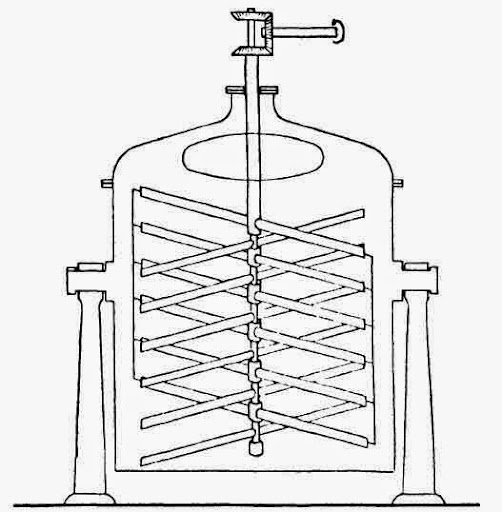(c) Alcoholic Extraits.
In the early days of perfumery, the fragment pomades
were employed directly; later they were extracted with high proof alcohol, the alcohol
dissolving the natural flower oil from the pomade. These alcoholic washings are
called Extrait No. 36 when made from Pomade No. 36; they reproduce the natural
flower perfume to a remarkable degree.
FIG. 3.23. Sketch of a Battcuse for the extraction of flower concretes with alcohol.
(The agitation is in counter-rotary motion.)
Since no heat is applied during the process of
enfleurage and during the washing of the pomades with alcohol, the extraits contain
the natural flower oil as emitted by the living flowers. The only disadvantage exists
possibly in a slight fatty "by-note" which can be eliminated to a certain
extent by freezing and filtering the alcoholic washings. This slight fatty "by-note"
is not always objectionable, as it imparts a certain roundness and fixation value
to the finished perfumes, especially in conjunction with synthetic aromatics.
In order to prepare the extraits, the pomades
are usually processed during the winter months when the factories are not busy with
other work. For this purpose the pomades are charged into so-called batteuses
(Fig. 3.23), closed copper vessels heavily tinned inside and equipped with strong
stirrers around a vertical shaft. Several batteuses are arranged in batteries, the
stirrers of each battery being driven by a powerful motor. The work, which goes
on for several months, is carried out in cool cellars in order to prevent loss
of alcohol by evaporation. Each batch of pomade is stirred for several days,
the usual process of methodical extraction being applied. The alcohol employed in
the process travels from one batch of pomade to the next (constituting in turn
the third, second and first washings of successive batches), until it becomes enriched
with flower oil and is drawn off as the alcoholic extrait. For the last washing,
fresh alcohol is used, which also, in its turn, becomes gradually enriched by the
continuous process just described. When extended to a fourth and fifth washing,
this method extracts the pomades so efficiently that the exhausted fat is quite
odorless. Being useless for new enfleurage it is usually employed for the making
of soap.
The fully circulated washing called "Extrait
No. 36" is run through a refrigerator and cooled to well below freezing temperature,
if possible to 15o, Most of the fat dissolved in the strong alcohol
separates. The cold alcoholic solution (Extrait No. 36) is then filtered, also
at low temperatures.
The quantity of alcohol to be employed for the
washing of each batch of pomade is calculated with a view to obtaining, finally,
1 kg. of extrait per kilogram of pomade. Obviously some alcohol is lost by evaporation
during the process of stirring.
The purified extraits reproduce the perfume of
the living flowers remarkably well. In fact, during the nineteenth century these
extraits were widely employed as bases of the classical French perfumes, and several
conservative houses still continue this practice. Some of the well-known French
perfumes undoubtedly owe their success partly to a high content of extraits. The
washing of the pomades is carried out not only by the factories in Grasse but in
some instances also by perfume manufacturers in Paris, London, Berlin and New York
who possess the necessary batteuses and freezing apparatus.
Since World War I, however, most perfumers have
discontinued the cumbersome practice of processing the pomades purchased in Grasse;
besides, high custom barriers prevented the shipment of alcoholic washings from
Grasse into foreign countries. For these reasons the Grasse manufacturers started
to offer their extraits in a more concentrated and convenient form.



0 Comment:
Post a Comment